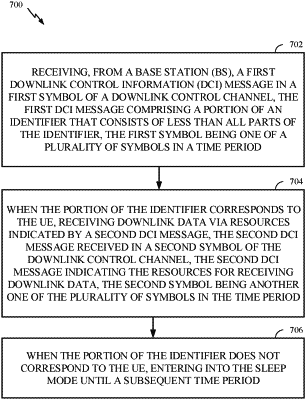| CPC H04W 52/0241 (2013.01) [H04L 5/0053 (2013.01)] | 28 Claims |

|
1. A method for wireless communication by a user equipment (UE), comprising:
receiving, from a network node, a first downlink control information (DCI) message in a first symbol of a downlink control channel, the first DCI message comprising a portion of an identifier that consists of less than all parts of the identifier, the first symbol being one of a plurality of symbols in a time period;
when the portion of the identifier corresponds to the UE:
receiving downlink data via resources indicated by a second DCI message, the second DCI message received in a second symbol of the downlink control channel, the second DCI message indicating the resources for receiving downlink data, the second symbol being another one of the plurality of symbols in the time period, wherein receiving downlink data via resources indicated by the second DCI message comprises receiving downlink data via resources indicated by the second DCI message when a communication parameter of a communication link between the UE and the network node as measured by the UE is equal to or greater than a threshold value, and entering into a sleep mode until a subsequent time period when the communication parameter of the communication link is less than the threshold value;
when the portion of the identifier does not correspond to the UE:
entering into the sleep mode until the subsequent time period; and
when the portion of the identifier corresponds to the UE, entering into the sleep mode until the subsequent time period when the communication parameter of the communication link is less than the threshold value.
|